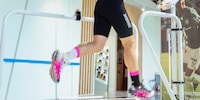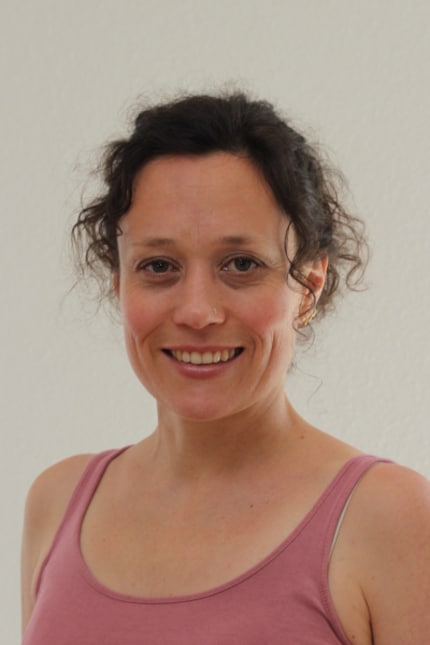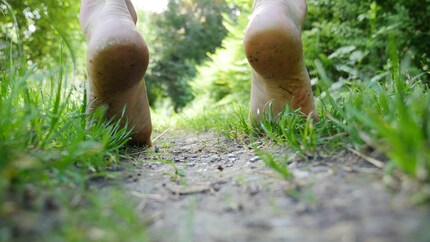
Background information
Why a running analysis was worthwhile for me – and might be something for you too
by Siri Schubert

Veronika Wanner hated going for a run. She took off her shoes and trained further. The sports scientist is now free of pain and teaches others the right technique. A conversation about barefoot walking and "natural running".
I want to learn to walk properly, step by step. Barefoot. The way nature originally intended. Okay, maybe even in minimalist shoes. After all, she gave us enough brains to protect our feet. Or to put them in the latest Yeezy sneakers. Or, or, or, or. The variety of shoes has exploded in recent decades and not every innovation is good for us, because our bodies can't always keep up with the supposed progress.
Good morning Veronika, are you wearing shoes right now?
Veronika Wanner, sports scientist: NO (laughs)!!! I don't wear shoes, I'm barefoot.
Very good, me too. We want to talk about barefoot running. You offer coaching sessions and teach people how to walk and run properly without shoes or in minimalist shoes.
The coaching sessions always take place barefoot. Then I can see even better what the foot is doing. And proprioception, i.e. body awareness, is different. There are studies that show that even a minimal shoe changes the kinematics.
How did you come up with the topic?Ultimately through my own problems. During my sports studies, I got so much pain below my left knee that I couldn't do anything at all. Then the odyssey began. From orthopaedist one to orthopaedist two. From physiotherapy to orthopaedist three. At some point, I was diagnosed with bowlegged splayfoot, hallux valgus, bow legs - the full programme. Insoles and physiotherapy didn't help me.
There are studies that come to the conclusion that people who wear minimal shoes don't injure themselves less often, but simply have other problems.
Exactly. With my experience, I can now see where this can be prevented. It's about getting back to anatomically sensible coordination.
What kind of feedback do you get from your clients?
When my oldest participant tells me with beaming eyes that he can go ski touring again without pain and has cancelled his knee operation - that makes me happy, of course. [[image:36131006]]
Coaching is a very individual story. Are there any general mistakes that should definitely be avoided when running barefoot?
The biggest mistake would be to buy barefoot shoes and immediately go for a normal jog in them. In the best case scenario, you'll suffer from sore muscles. In the worst case scenario, you'll immediately suffer your first overuse injuries.
Simple writer and dad of two who likes to be on the move, wading through everyday family life. Juggling several balls, I'll occasionally drop one. It could be a ball, or a remark. Or both.
Interesting facts about products, behind-the-scenes looks at manufacturers and deep-dives on interesting people.
Show all
Background information
by Siri Schubert

Background information
by Michael Restin

Background information
by Siri Schubert
There are renowned orthopaedists and biomechanists who speak of "rape" or a "prison" for the feet in connection with running shoes. "Natural running" is the counter-movement. Veronika Wanner is a sports scientist and movement therapist in Winterthur who coaches her clients on the path to an anatomically and physiologically correct barefoot gait. She tells me more about it on the phone.

That sounds frustrating. What happened next?
At some point I was told: We could operate on your knee. No, thank you. An osteopath managed to fix me up so that I could complete my studies. But it didn't get really good. Walking was terrible for me anyway. When barefoot shoes came along, I tried them again and got my problems under control after various training courses. I now really enjoy walking. I've learnt that it can feel really great - almost like flying!
Is there such a thing as a typical customer in your coaching sessions? After the first article on the topic, it was mainly men who wrote to me. Most of them are a bit older.
No, that doesn't exist. I have a surplus of women in therapeutic training, but it's more balanced in barefoot coaching. Generally speaking, I have clients from their mid-twenties to over 80, both men and women.
Why do they come to you?
There are two typical motivations. For some, it's pain. They often have a similar odyssey behind them as I have. Others are interested in barefoot shoes and don't know how to walk in them. What is right and what is not? Bunion gait - yes or no? This is discussed in the barefoot communities and there is a great need for information. These people come without any previous complaints. However, many also start to look into barefoot shoes because of back pain.
I had a similar experience. I know that I need to do something for my knees because of a misalignment. And I occasionally had pain in my lumbar spine. Both seem to have improved since I've been walking barefoot or in minimalist shoes more often.
It may well be that your improvement comes from running barefoot. However, there is no guarantee that improvements will occur as soon as you switch to minimal shoes. However, when I look at how a foot should move, at some point I almost automatically switch to barefoot running or minimal shoes. If you know how, you can move your foot as anatomically as possible in a conventional shoe and also do targeted balance training. But you can also save yourself the trouble and make compensation training superfluous by not wearing shoes at all or by wearing minimal shoes that are as unobstructive as possible.
What does this change?
Barefoot shoes strengthen the foot muscles and most people adapt their movements at least a little when they walk or run in them. This alone can have a positive effect on complaints. But just because you give a structure freedom doesn't mean that it will automatically return to good coordination. I also see a lot of people in barefoot shoes who buckle their feet. I definitely needed additional training to get my problems under control.
What would be the first steps if I were to come to you for coaching?
First of all, I would let you walk a few metres. I would look at your feet and see if they are well coordinated. Most of the time, you'll find that there's already enough of an approach. I would like the longitudinal arch to be stable. And that the transverse arch is stable and active. I'd like the foot not to bend and the leg axis to run smoothly. So with the knee straight ahead. The pelvis, lower back and torso also need to be involved. I very rarely see well-coordinated people. We all sit far too much and rarely have good movement role models. A lot can be changed here.

This doesn't just affect non-athletic people. I remember an aqua jogging session in sports studies that we were allowed to watch underwater. Apart from one sprinter, it was quite an uncoordinated affair.
I am such an example myself. I have a history of gymnastics and dancing. My feet and legs were still completely uncoordinated when I ran - a disaster! But it can be learnt. You can change a lot. My bow-legged splayfoot is a thing of the past, my hallux valgus is gone, as are my bow legs.
Let's talk about spiral dynamics. A concept that you've trained in. It's similar to barefoot running: There's a lot to be said for it, it's controversially discussed, but there are no long-term studies to prove its effect. Can you explain what this is about?
Spiral Dynamics is an instruction manual for the whole body. It can be used in therapy, but also for prevention or to improve performance. It has given me a real plan of what anatomically sensible movement looks like in detail. I know which joint should move how and when and which structures are involved in the movement. Above all, I know where I can start if things are not running smoothly. With an uncoordinated foot, barefoot running is also really difficult.
The whole concept is based on instructions for coordinating movements?
Exactly. It's a concept that is based in detail on how the bones are shaped and arranged and which muscles, fascia, tendons and ligaments are involved. There are still very few scientific studies on this at the moment. However, there are systems that work in a very similar way. And it has worked for me. I can now go running without getting any pain. That's a highlight for me! I didn't get any similarly targeted running coaching during my studies, even though I specialised in prevention and rehabilitation.
What period of time should someone who wants to change their gait aim for?
Months. The muscles adapt relatively quickly. The foot and calf muscles become stronger and more enduring within weeks. However, it is not only muscles that are attached to the bones, but also many fascial structures. These are slower to adapt and take months to become flexible and strong enough to absorb the strain well. You should start really carefully and increase very slowly, it can only be ten minutes of walking a day at the beginning. You shouldn't start running straight away.
Is there a "right" running technique for you? There is a lot of discussion about forefoot or midfoot running
The foot strike depends on your speed and the surface. The terms forefoot and midfoot running are sometimes used differently, which makes it difficult to give a simple answer. When walking, the heel lands first. With increasing speed, the foot lands further forwards first, and when sprinting, the heel has no contact with the ground at all. Barefoot or in minimal shoes, most people automatically switch from heel to forefoot running. In any case, a stable, active and pre-stressed longitudinal and transverse arch is important.
For many people, the holiday season is the only time of the year when they walk barefoot. Can you give people a tip for the beach or lakeside?You can make something like a barefoot path yourself. A variety of input is great for your feet. Different surfaces. Stones, round stones, sand, meadow, sometimes balancing on a tree trunk. Whatever is available. A variety of stimuli is a good start. You should be aware of them and enjoy them!If you are interested in my next barefoot steps, you can follow me here as the author. At some point, my path will also lead me to Veronika in Winterthur.


Acer Nitro VG271UM3bmiipx
2560 x 1440 pixels, 27"